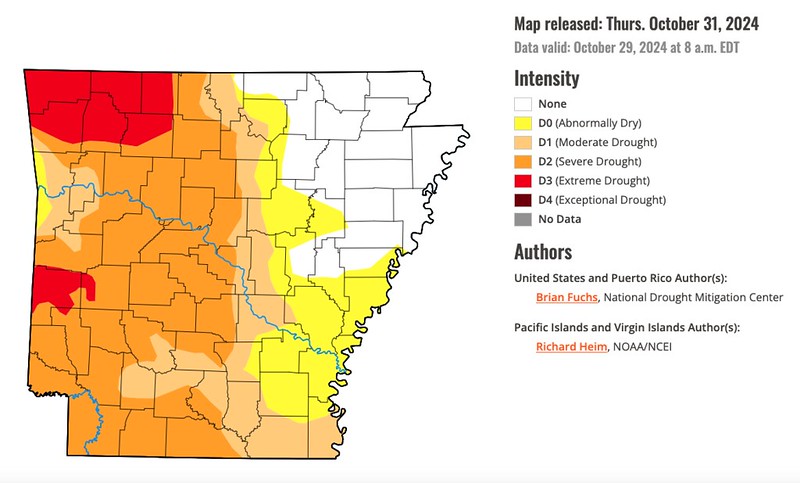Months of drought conditions complicate winter feed strategies
Nov. 4, 2024
By Ryan McGeeney
U of A System Division of Agriculture
Fast Facts:
- Dry September, October placing pressure on pastures
- Cattle industry already in liquidation phase since 2019
- Strip-grazing recommended
(632 words)
(Newsrooms: With U.S. Drought Monitor Map)
LITTLE ROCK — The dry, warm autumn experienced by much of Arkansans’ pasture lands will likely mean the state’s cattle producers will have to start feeding hay earlier and longer, experts with the University of Arkansas System Division of Agriculture said.
While the western half of Arkansas received some much-needed rain throughout the weekend, it won’t be enough to reverse months of drought.
Kenny Simon, extension forage educator for the Division of Agriculture, said the extended drought has both impacted the growth of fescue, the state’s most common cool-season perennial grass, and delayed the planting of warm-season perennial grasses.
“Everyone’s scared to plant because of how dry it is,” Simon said. “As a result of that delayed planting, we’re going to have a delayed growing period.”
While bermudagrass, for example, is normally planted between mid-September and mid-November, many producers won’t be able to plant until November at the earliest, he said. This likely means the grass won’t be available for grazing until later than normal in spring.
Meanwhile, Simon said, the state’s fescue pastures are growing unusually sparse in many fields across the state.
“A lot of our pastures are getting grazed down really short right now,” Simon said. “What growth remains is getting grazed really close to the ground, which opens up the canopy for undesirable broadleaf weeds and other grasses. It’s weakening the root systems of those perennial grasses.”
From grass to cattle
Sparse forage and elevated feed prices can often lead producers to decide it’s better to sell off a cow than overwinter it, but cattle producers in Arkansas and surrounding states have already exercised that option for much of the past five years.
James Mitchell, extension livestock economist for the Division of Agriculture, said that much of the U.S. cattle industry has been in a “liquidation phase,” with producers culling herds for much of the last five years.
“We’re coming off a couple of years of some pretty hard liquidation,” Mitchell said. “Our herd sizes are already pretty moderated, so I don’t see culling decisions being accelerated, just because we don’t have a lot of cows to start with.”
Grass in the tank
Fortunately, many Arkansas producers were able to get two cuttings of hay earlier in the year and have stockpiled enough to get through at least a normal year, he said. And while 2024 isn’t shaping up to be a normal year in this instance, it’s better than nothing.
“The drought hit late enough in the season that most producers had adequate hay on hand by the time things got bad,” Simon said. “I think most folks got the hay they need for a normal year, but these fall droughts may force people to start feeding three to four weeks early. When you compound that with planting annuals later than normal, we’re going to end up feeding hay a lot longer than most people anticipated.”
Simon recommended that growers try to make any remaining forage last by using moveable electric fence to “strip graze,” the process of confining a herd to a specific area for a set period of time before allowing them access to other grazing areas.
“Give the cows a limited supply of forage, maybe two to three days, or maybe even move them just once a week,” Simon said. “What we’re trying to do with strip grazing is improve the use of the forage and get it passed through to the animal.
“Once you start feeding hay, confine those animals to one pasture,” he said. “Maybe it’s a field that’s low in soil fertility and we improve it with the cows’ waste as fertilizer. By rotating the cows onto a different field every two to three weeks, we can spread the fertilization out over a broader area, instead of concentrating it in one field.”
To learn about extension programs in Arkansas, contact your local Cooperative Extension Service agent or visit www.uaex.uada.edu. Follow us on X and Instagram at @AR_Extension. To learn more about Division of Agriculture research, visit the Arkansas Agricultural Experiment Station website: https://aaes.uada.edu/. Follow on X at @ArkAgResearch. To learn more about the Division of Agriculture, visit https://uada.edu/. Follow us on X at @AgInArk.
About the Division of Agriculture
The University of Arkansas System Division of Agriculture’s mission is to strengthen agriculture, communities, and families by connecting trusted research to the adoption of best practices. Through the Agricultural Experiment Station and the Cooperative Extension Service, the Division of Agriculture conducts research and extension work within the nation’s historic land grant education system.
The Division of Agriculture is one of 20 entities within the University of Arkansas System. It has offices in all 75 counties in Arkansas and faculty on five system campuses.
Pursuant to 7 CFR § 15.3, the University of Arkansas System Division of Agriculture offers all its Extension and Research programs and services (including employment) without regard to race, color, sex, national origin, religion, age, disability, marital or veteran status, genetic information, sexual preference, pregnancy or any other legally protected status, and is an equal opportunity institution.
# # #
Media Contact:
Ryan McGeeney
rmcgeeney@uada.edu
@Ryan_McG44
501-671-2120
